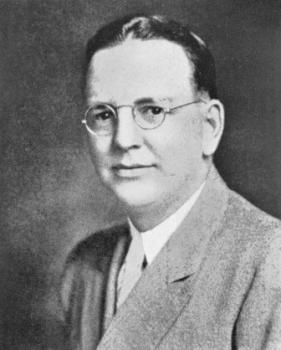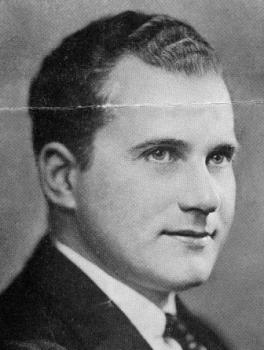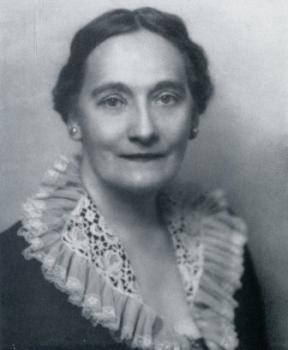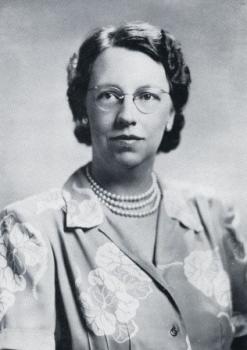Philip Milo Bail, President, 1935-1940

In 1935 Philip Milo Bail was appointed President of Chevy Chase Junior College. Bail was born in Booneville, Missouri in 1898, and he received his MA in 1928 and PhD in 1931 from the University of Iowa. After teaching high school in Iowa, Bail became the supervisor of secondary schools for Hibbing, Minnesota, and served as the President of the University of Iowa Experimental High School. At Chevy Chase, Bail worked to assure that all students received the personal attention and instruction they required. He believed that teaching in this style, as well as limiting enrollment at the school to 100 students, would help develop a strong sense of leadership and self-confidence among Chevy Chase graduates.
Under his presidency, Chevy Chase began awarding the Associate of Arts degree to graduates of the junior college. Bail also oversaw many improvements of the school’s facilities. In 1939, the College purchased a nearby home that functioned as a domestic practice house. In addition, he expanded the music department by creating a new sound-proof studio for practice. Bail left Chevy Chase Junior College in 1940 after being named the Dean of the Butler College of Education at Butler University. In 1948, Bail became the President of Omaha University where he served until his retirement in 1965.
Kendric Nichols Marshall, Acting-President, 1940-1941; President, 1941-1942

Kendric Marshall followed Philip Milo Bail, serving as Acting President in 1940, and President in the next academic year. Before coming to Chevy Chase Junior College, Marshall was an instructor in history and government at Harvard University. He was very concerned with the practical application of lessons learned from real world situations. He implemented a program at Chevy Chase in which academic classes were supplemented with “first-hand observation of government in action.” Promoting his new program Marshall said, “All our schools have a responsibility for translating a vast amount of knowledge into some kind of action, to help save our democratic way of living and to make our country more able to cope with its problems.” Through this new curriculum plan, the girls of Chevy Chase Junior College could gain a better understanding of fundamental American political institutions in order to become active and contributing members of society. After leaving Chevy Chase in 1942, Marshall worked for the United Nations Relief and Rehabilitation Administration during World War II, and later served in the State Department.
Carrie Sutherlin, President, 1942-1947

Carrie Sutherlin was a graduate of the State Teachers College of Virginia, later called Longwood College, in Farmville, Virginia; she received an MA from Columbia University. She taught English at many schools, including Chatham Hall, Sullins College, Alabama Women’s College, and Longwood College. Her administrative career began in 1927, when she left Longwood to become Dean of the newly formed Arlington Hall Junior College, a private high school and junior college for girls on a large campus about six miles from the Capitol in nearby Virginia. She was appointed Principal and (later President) in 1933. During her tenure as President, enrollment increased and new facilities were constructed, though there are reports that during the worst years of the Great Depression, teachers were compensated only with room and board. Despite these challenges, she was among the best known women educators in the Washington region, and she was an active participant in organizations such as the National Association of Junior Colleges.
In addition to her administrative leadership, she also gave a number of lectures on poetry to local groups and associations in the DC area. In 1942, the Arlington Hall Junior College campus was taken over by the Army Signal Intelligence Service to assist its operations for the war effort.
Shortly afterward, she accepted the position of President of Chevy Chase Junior College, and she brought a number of her Arlington Hall administrative and teaching staff with her. As she had at Arlington Hall, Sutherlin made sure that wartime aid projects became a central part of academic life for students. In a Washington Post article, she was quoted as saying, “Each department will correlate its activities in some way with the war effort and schedules are being planned to allow the students as much time as possible for volunteer service.” In 1946 under her leadership, the college enrolled 119 students, the largest in its history. Sutherlin continued to attract faculty to the school to teach the growing number of students, and rented a nearby house for additional students for the duration of that school year. Despite this increase in enrollment, in 1947 Sutherlin resigned her position as President of Chevy Chase Junior College and returned to her alma mater, Longwood College, where she taught English until 1952. After her retirement from Longwood, she continued to live in Farmville.
Frances R. Brown, Dean, 1944-1947; President, 1947-1950

Serving as Dean of Chevy Chase Junior College from 1944, Frances Brown was appointed President in 1947. Brown received a BA in English from Wells College, and was awarded an MA by the University of Chicago in 1930. She held a teacher’s certificate in voice from the Peabody Conservatory in Baltimore, and was a former instructor at Arlington Hall Junior College under the leadership of Carrie Sutherlin, where she was the head of the English Department. During World War II, Brown was associated with the Red Cross for 18 months, doing editorial work at its headquarters. Frances Brown led the Chevy Chase School through its final years of operation, overseeing the construction of a new building which was to house the science and technical departments, as well as the remodeling of the art studio and secretarial science department to accommodate a growing number of students. But these improvements did not prevent the eventual closing of the school, and perhaps an over-ambitious building campaign helped contribute to the financial difficulties it faced.
Miss Brown later served as Academic Dean of Pine Manor Junior College in Wellesley, MA. In 1957, she was appointed Dean of Residence and Student Affairs at Radcliffe College, in Cambridge, MA. In 1961, she left Radcliffe and became a member of the faculty and staff at Longwood College, in Farmville, Virginia, retiring as Associate Dean of Students in 1973. She died in 1998, at the age of 90.


